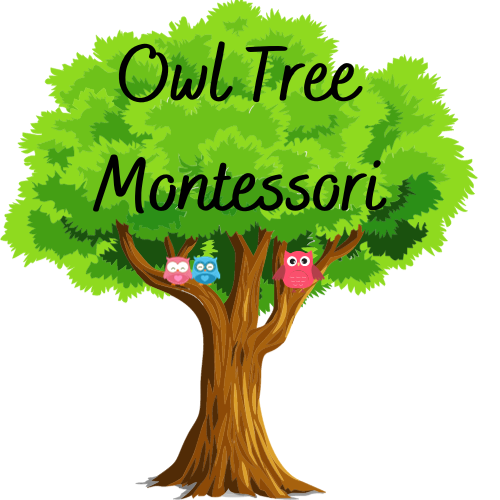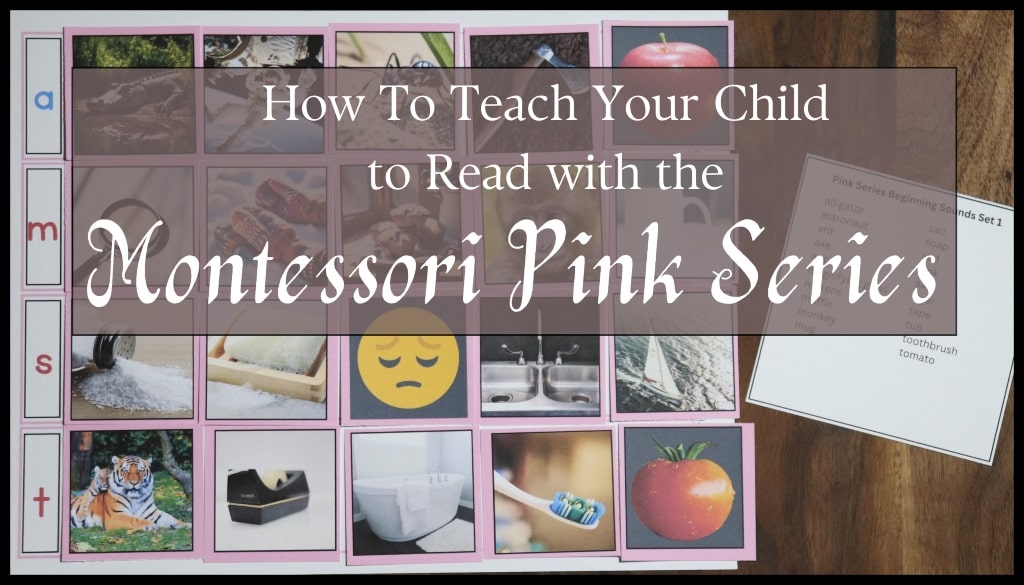The Montessori Pink Series introduces children to the letter sounds and symbols of the alphabet. The series progresses to consonant-vowel-consonant (CVC) words like cat, bed, lip, pot, and bus. Your child can read with the Montessori Pink Series!
Teach the Beginning Sounds First
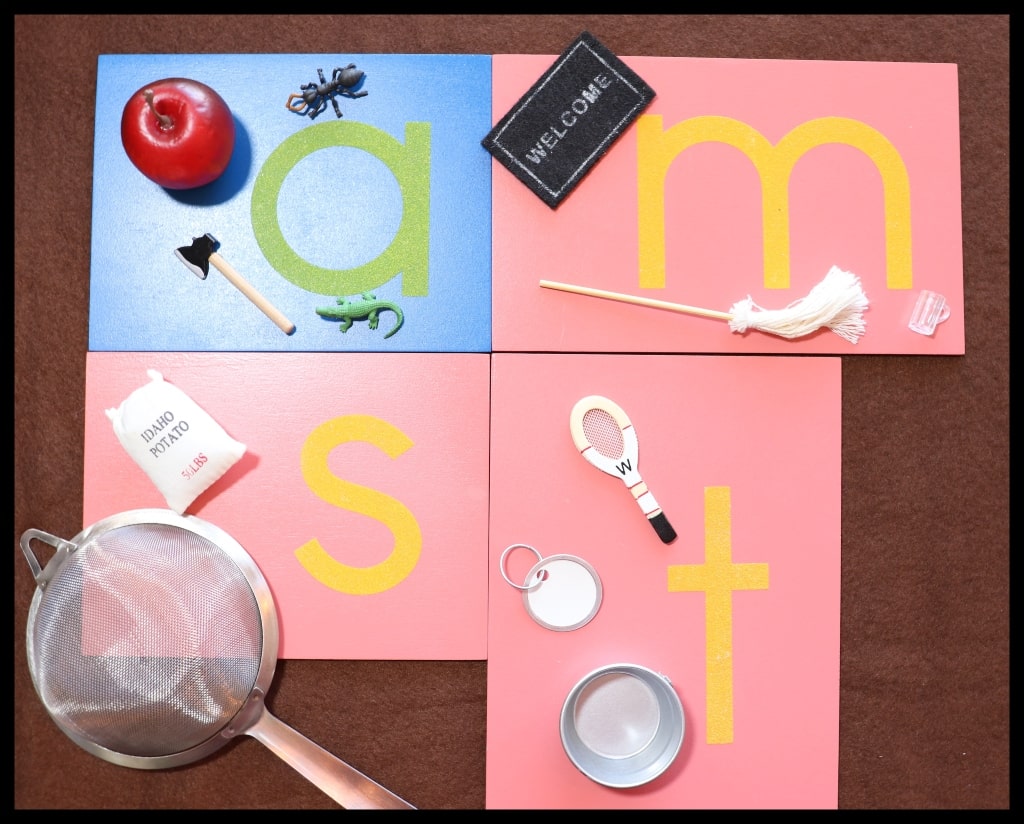
To begin to read children must recognize the 26 phonemic sounds and each corresponding letter symbol of the English alphabet. A child must recognize that the sound /m/ is represented by the symbol “m”. To read with the Montessori Pink Series give your child the Beginning Sounds lessons and activities. They combine phonemic awareness (the auditory discrimination of an individual sound unit) with letter symbol recognition.
Children listen to and identify the beginning sounds in objects and pictures, then match them with their letter-symbols. The Montessori materials used for beginning sound lessons are:
- Sound Objects
- The Sandpaper Letters
- The Sand Tray
- Beginning Sound Pictures
Our Pink Series Beginning Sounds Matching Cards can be downloaded from our Teachers Pay Teachers store!
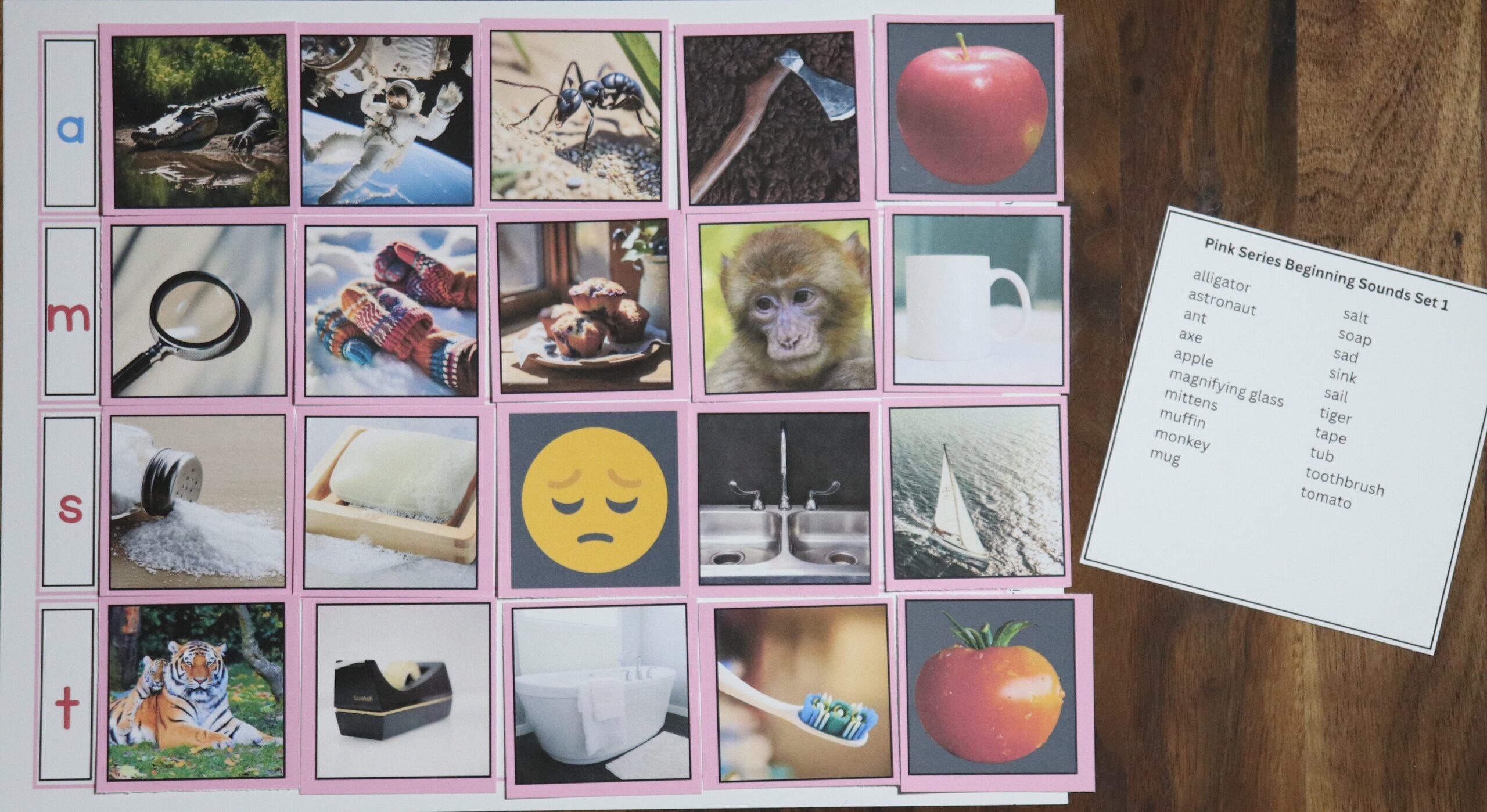
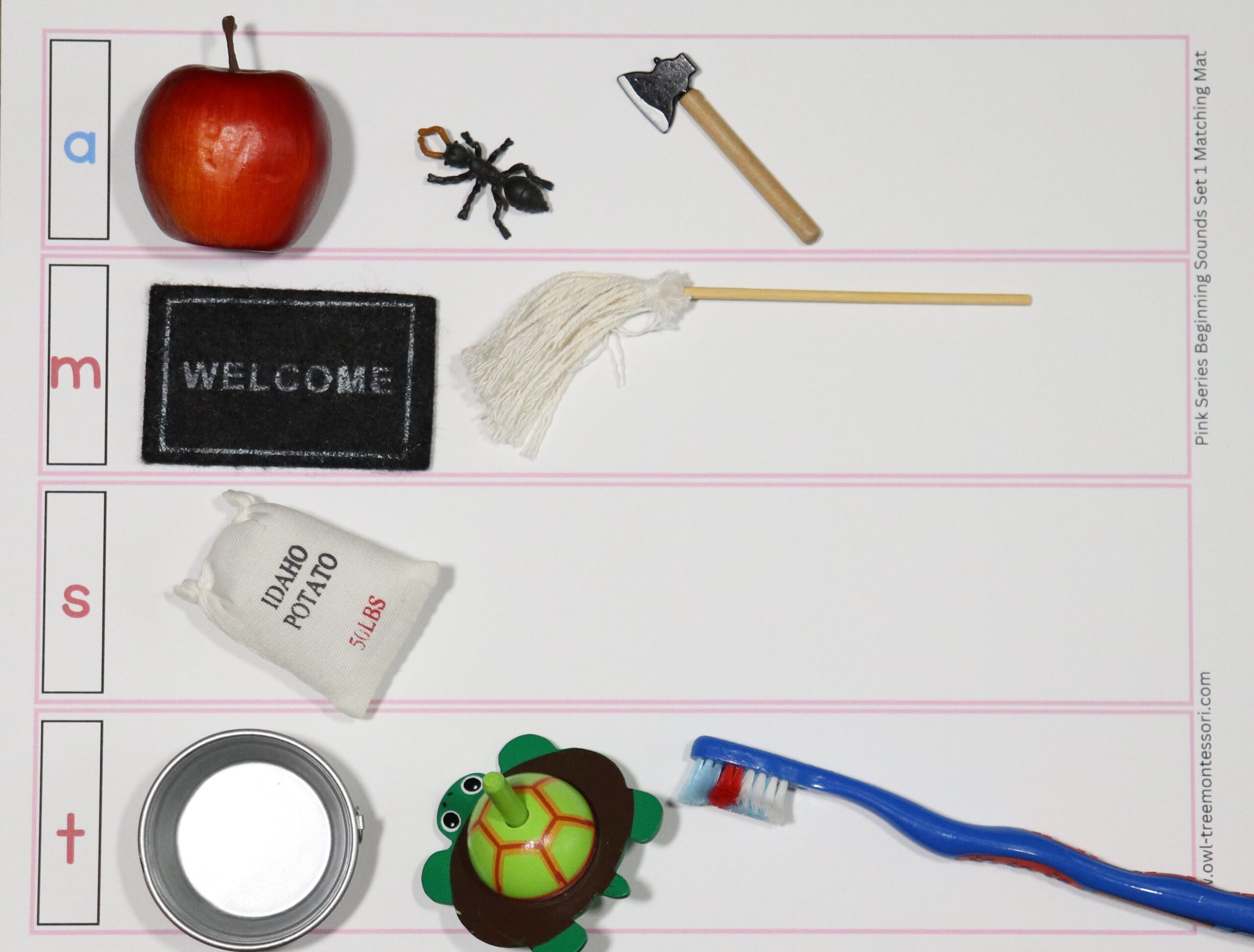
Next, Teach the Ending Sounds in Words
Once a child learns all 26 letter sounds and symbols, the focus shifts to the ending sounds in words. Children must understand that letters (and their sounds) can be put together to make words. The next step to read with the Montessori Pink Series after beginning sound identification is to listen to and identify the sound at the end of a word. Two things happen with the Montessori Pink Series Ending Sounds Lessons:
- Reinforcement of letter sound/symbol identification skills
- Extend learning and awareness that letters form words by isolating ending sounds in words
The Montessori materials for ending sounds are:
- Ending Sound Objects or Pictures
- The Moveable Alphabet
Lastly, Teach the Middle Vowel Sounds in CVC Words
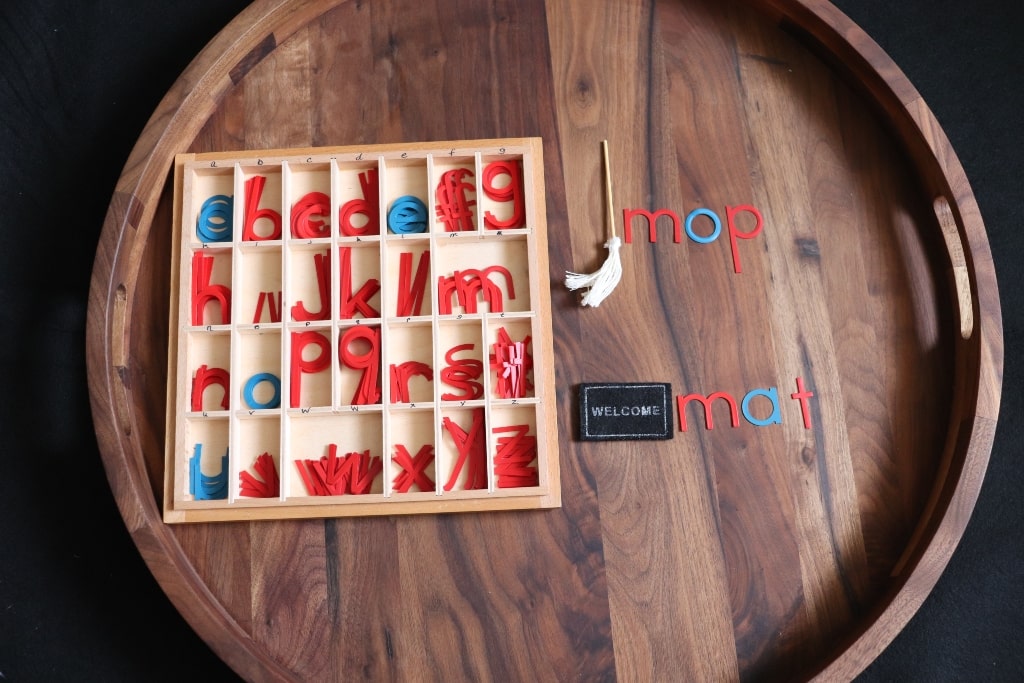
The final step to read with the Montessori Pink Series is the Middle Vowel Sound lessons.
To facilitate early reading success only short 3-letter words (like “mop”) with a consonant-vowel- consonant (CVC) pattern are used to teach this concept to children. These words build on the beginning and ending sound identification skills, introduce short middle vowel sounds, and allow children to begin reading.
The middle vowel sounds are the most challenging for a child to differentiate. Think about how the letter sounds /e/ and /i/ are so similar. They need a lot of practice to become proficient with middle vowel sounds.
As an introduction, children work with sets of words that share a middle vowel sound. For example: cat, cap, hat, van, can, fan, ram, etc. Later they work with mixed sets that include different middle vowels.
The Montessori materials used are:
Object /Picture Word Sets
Children listen to the individual beginning, middle, and ending sounds for each and use the Moveable alphabet to encode the word. Finally, they decode (read) the word.
The Moveable Alphabet
Children look at the pictures or objects representing a CVC word, build the word with the moveable alphabet. They can use written word cards that correspond to each picture or object to self-correct their work verifying they have chosen the correct letters to represent each sound.
The Vowel Tree
A picture of a tree with all five vowels printed on the trunk gives children the opportunity to practice each vowel sound. For example,
The child holds a card with the beginning letter “m”, a cut out square window for the middle vowel, and the ending letter “p”.
The child places the square window over the “a” at the top of the tree trunk. The word now reads “map”.
The child moves the card down, so the “e” now fills the window. The word reads “mep”. (Discussion can be had about nonsense words vs. words that make sense. Nonsense words are often used by instructors in phonics games and assessments.)
Continue moving the card window over each vowel, to practice changing the vowel sound in a word.
It will look like this: map, mep, mip, mop, mup. Again, for the purpose of this exercise it is ok to use nonsense words.
Writing (Encoding)
When children listen to an individual sound in a word and represent it with a written letter symbol from the moveable alphabet, they encode the word. Encoding words is writing words.
Though we typically think of writing as the physical act of handwriting a word with a paper and pencil, encoding is the cognitive skill needed to “write” a word. Children can encode words (write them) using wooden letter pieces from the Moveable Alphabet before they have the fine motor skills and muscle strength to write with a pencil and form correctly written letters on paper.
This allows children to move forward with “writing” (encoding) and reading words while at the same time they develop the motor skills, muscle strength, and proper letter formation necessary to write words with paper and pencil using other materials like Practical Life Exercises and the Sandpaper Letters.
In fact, encoding words with the Moveable Alphabet letters and reading them aloud becomes a huge motivation for children to pick up a pencil and paper and write words to be shared with others.
The Encoding Process with the Moveable Alphabet
With the Montessori Pink Series children begin with objects or a picture. Then they use phonemic awareness to identify an individual sound. Finally, they represent that sound with a letter symbol. They are writing… before they are reading! For example,
- The child looks at a picture of a mop
- She identifies the beginning sound /m/
- She finds the letter “m” in the box and places it next to the picture
- She identifies the middle sound /o/
- She finds the letter “o” in the box and places it to the right of the “m”
- She identifies the ending sound /p/
- She finds the letter “p” in the box and places it to the right of the letter “o”
The child has written (encoded) the word mop, though she has not yet “read” the word mop. The last and final step is to read (decode) the word she wrote.
Reading (Decoding)
After children write/encode a word using the Moveable Alphabet, they blend the sounds from left to right to read the word. Children decode words when they look at a written word, break it down into sound parts, then blend it smoothly. This is reading. For example,
- The child starts at the left and moves to the right saying each sound; /m/, /o/, /p/.
- Again, the child begins at the left and moves right, but this time she blends it more smoothly; /mmmm/, /oooo/, /p/.
- Finally, the child reads the word on last time from left to right quickly and fluently; “mop”.
In a Montessori classroom, we see children writing (encoding words by listening to the individual sounds and choosing a letter to represent that sound) before they begin reading (decoding a word by breaking it down into its sound parts, then blending the sounds together smoothly as a whole word) using the Montessori Movable Alphabet.
Making the Reading/ (Hand) Writing Connection
To make the reading/(hand) writing connection for your child, give him/her the opportunity to write the words they encoded and read using the moveable alphabet with paper and pencil. The physical handwriting of words requires strong fine motor skills and proper letter formation. This can be frustrating and discouraging for some children. Here are some tips:
- If your child struggles with the fine motor skill of handwriting, give him/her some Practical Life activities to strengthen the muscles.
- Reinforce the formation of a difficult letter with the Sandpaper Letters and Sand Tray.
- Give your child the word they are trying to write in broken dashed lines for him/her to trace.
- To begin, have your child write words on unlined paper.
- Give an explicit lesson on how to use lined paper.
- Experiment with different lined papers.
Teaching your child to read with the Montessori Pink Series combines explicit teaching of letters and their sounds with Sound Objects, Sandpaper Letters, the Sand Tray, and the Moveable Alphabet. This series of lessons and materials teaching reading in an engaging way. Give your children consistent practice with the materials and they will become confident, proficient beginning readers.
